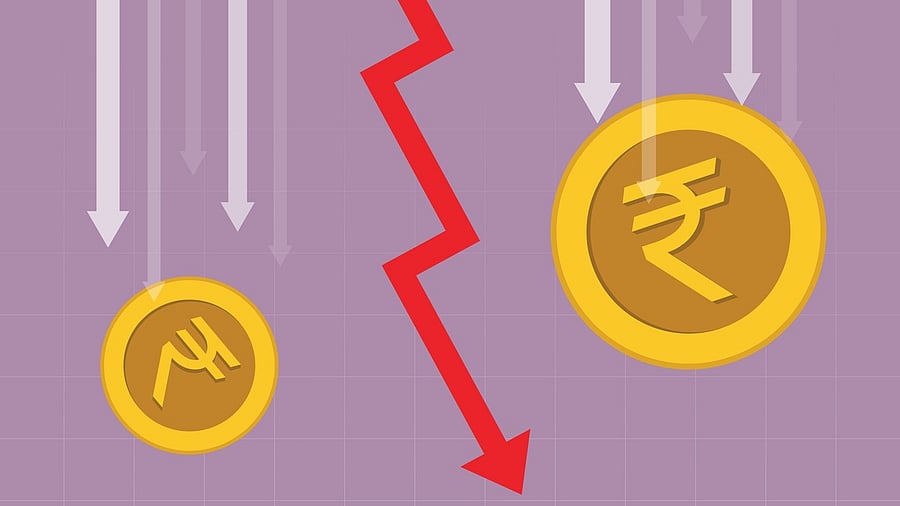
Representative image of rupee falling.
Credit; iStock Photo
The Indian rupee has been depreciating since October 2024. On January 8, the third day of the first full working week in the new year, the fall in its value remained unabated. The rupee opened at Rs 85.82/US$ and touched the lowest-ever level of Rs 85.89. The irony is that India’s foreign exchange (forex) reserves touched the highest of $705 billion in September 2024, with the exchange rate at Rs 83.79/US$.
The fall commenced after a big-bang cut of 50 basis points (bps), on September 18, by the United States (US) Federal Reserve (the Fed) in its policy interest rate. The Fed implemented two subsequent cuts before the end of the year – by 25 bps on November 7, just after Donald Trump’s victory in the presidential election, and by another 25 bps on December 18.
The markets were pleased with the cuts, raising hopes of recovery. Meanwhile, the economists started debating whether the US economy was nearing a neutral interest rate, where growth has been commendable at 2.7 per cent with inflation (2.7 per cent) above the Fed target rate of 2 per cent. Is the US economy closer to tasting the fairytale Goldilocks soup, “neither too hot nor too cold”?
A very optimistic picture of the US emerged after Trump entered the election with his ‘Make America Great Again’ slogan and a slew of campaign promises that included a big reduction in the rate of corporate tax and bringing back from China the US-owned manufacturing companies. Threats of high tariffs on imports followed – 100 per cent on imports from China, and 60 per cent on those from India, which he called “the king of tariffs.”
These utterances instigated the ‘hot money’ outflows from the emerging economies to America. Foreign Portfolio Investors (FPIs) were highly impressed with Trump’s campaign promises. As their interests are only in short-term gains, they pulled out investments in stocks and bonds from emerging economies.
We’ve often heard how if America catches a cold, the less developed countries get pneumonia. Now, we have seen if the US is hale and hearty, the developing economies will face the outflows of capital, leaving them high and dry and pushing other currencies down. Yet, the rupee performed well in 2024. It went down only by 2.8 per cent when currencies of other emerging economies, including Brazil’s real (20 per cent), Mexico’s peso (18 per cent) and Korea’s won (12 per cent) reported severe depreciation against the dollar.
Navigating man-made shocks
One effective tool systematically employed by India in similar situations earlier has been the Reserve Bank of India (RBI)’s foreign exchange market intervention. It was resorted to, again – the selling of dollars to reduce the volatility.
Critics say that under the floating exchange rate regime, India should permit the exchange rate to be determined by market forces. In 2023, the IMF advised India that instead of intervening, “a flexible exchange rate should act as the first line of defence in absorbing external shocks.”
However, the Indian economy is not as diversified as the US or China. These shocks are not natural; they are created by policies that are not in the global interest: protectionism, threats of tariffs, and inducing manufacturing units shifting to the US to produce behind a tariff wall. It is less about a falling rupee than it is about a strengthening US dollar.
Furthermore, all the emerging and developing countries were impacted by the dollar’s rise and their capital outflows became inflows to the US. Theoretically, a depreciation of the rupee renders Indian exports cheaper to the importers outside.
However, the demand for Indian exports abroad is relatively price-inelastic. Hence, Indian exports do not have a reasonable chance of translating to big money.
In 2022, the narrow range within which India’s exchange rate fluctuated led to the impression that India intervened excessively, aiming at a particular exchange rate. The RBI assured that it did not target any specific exchange rate. Its intervention in the forex market is “both ways only to tackle undue volatility.”
In October 2023, the then RBI Governor Shaktikanta Das told IMF officials that market intervention should not be viewed in black and white – “the term is more nuanced, as emerging market economies have to deal with consequences of policy actions of the countries in the developed world.”
The time has come for India to place a much greater emphasis on export-oriented growth. Trade is the engine of growth in a globalised world and a closer integration with global value chains becomes imperative.
(The writer is a former senior economist, Asian Development Bank)